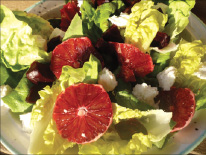http://www.losaltosonline.com/index.php?option=com_content&task=view&id=20445&Itemid=133
Blood oranges bring bold color in winter
Written by Eve Hill-Agnus - Special to the Town Crier
Tuesday, 02 February 2010
 Photo Photo Courtesy Of Eve Hill-Agnus
Photo Photo Courtesy Of Eve Hill-Agnus
Colorful oranges add a touch of vibrant
color to a leafy salad.
First-person accounts from as recently as 100 years ago have New Englanders thrilling at the arrival of kin from the balmy, dreamy, citrus paradises of California or Florida, precious navel or Valencia oranges in hand. This winter fruit was once a special stocking stuffer and prized holiday treat.
Ordinary oranges make no such stir today, but the striking blood orange still retains the exotic allure its cousin once possessed.
A blood oranges color is so singular it encourages storytelling. The first green grocer to hand one to me accompanied it with a story about how its carmine tint came from growing at the base of grapevines. Given their name, one could surmise more sinister tales.
The truth is, the fruits alluring color, ranging from flame-orange to garnet, violet and even deep purple depending on the variety, comes from anthocyanin pigments, found in flowers and berries but not other citrus fruit. Anthocyanins give blood oranges a subtle raspberry flavor and contribute to higher antioxidant levels than other citrus.
These same pigments, activated by chill nights, make deciduous trees burst into orange and red flame in fall.
Blood oranges hail from Sicily, where they appeared as a fortuitous mutation several centuries ago. Our most common varieties are the Tarocco, Sanguinello and Moro, the last being the youngest and most fiercely purple.
While most blood oranges are still grown in Italy where they dominate the orange business and Spain, in the United States they grow in California (November through May) and Texas (December through March), where day/night temperature differences mimic the Mediterranean climate that best suits the fruit and allows it to develop its distinctive color.
Blood oranges are at their best in dishes that highlight their ruby beauty. They dazzle in a deep-hued marmalade, a cocktail or granita, or as striking scarlet disks on an open-faced tart (see Food and Wine magazines recipe from this time last year:
www.foodandwine.com/recipes/flaky-blood-orange-tart).
They add a twist to the usual orange-slice garnish for pork roast or duck breast. And they make beautiful additions to salads, their crimson segments complementing a bed of greens.
The following recipe for a simple and versatile salad is excellent with a dressing of olive or walnut oil, the juice of one orange and a touch of honey.
Ricotta salata may be substituted for the goat cheese, and a few sprigs of arugula or mesclun can add a piquant touch. Toasted walnuts are also a nice addition.
Blood orange, roasted beet and goat cheese salad
head butter lettuce
1 bunch beets (red, golden or a mix of both), roasted
2 blood oranges, peeled and sliced into rounds
1 small round of goat cheese, or 1/2 a log
To roast beets, wrap in foil or halve and drizzle with oil on baking sheet. Bake at 400 F until tender when pierced with fork. Cool thoroughly.
Wash, dry and trim lettuce, then layer with cubed beets, blood orange slices and dabs of goat cheese. Drizzle with dressing and toss gently just before serving (to avoid beet-color bleeding).
Makes two to three servings.




